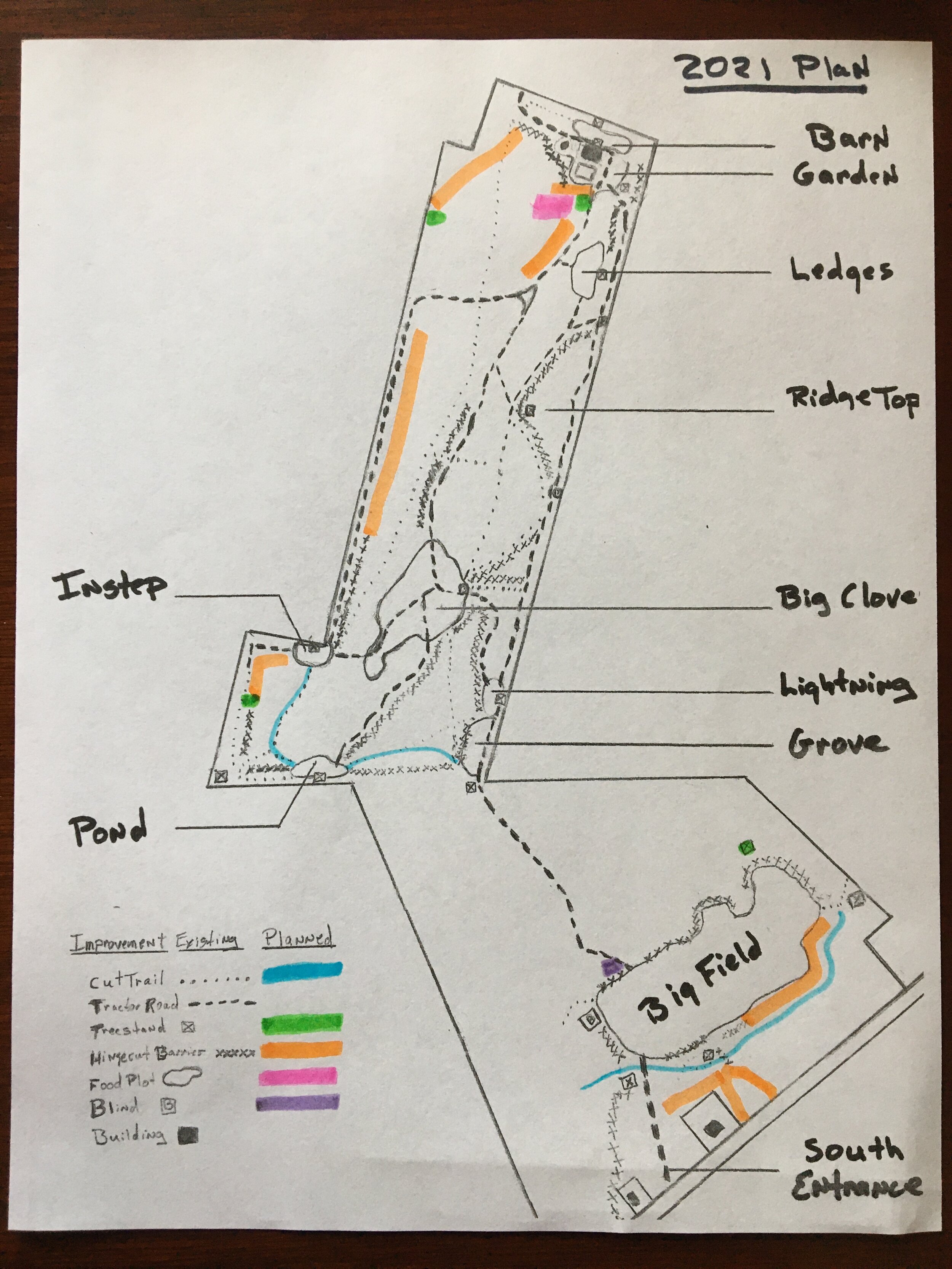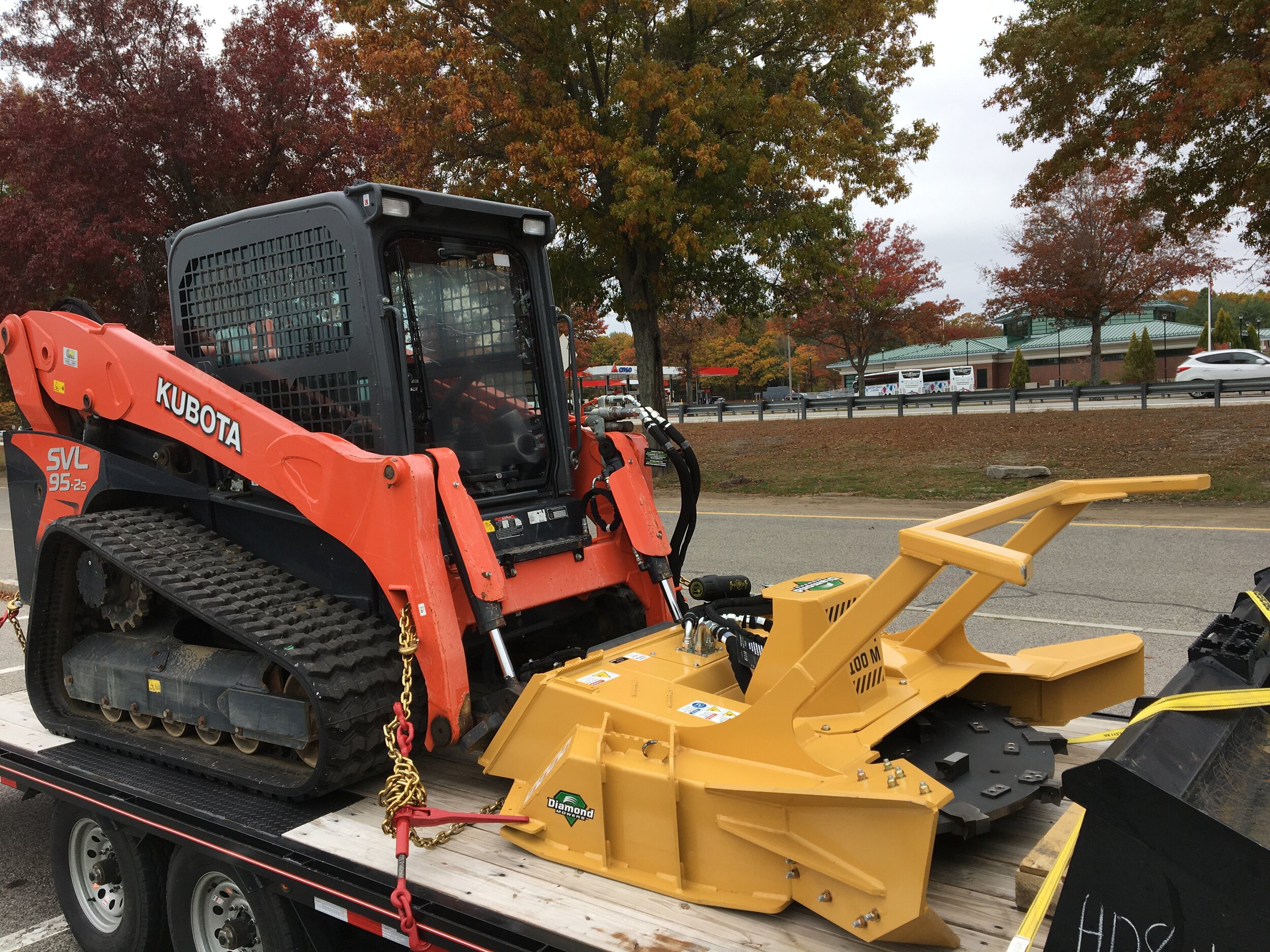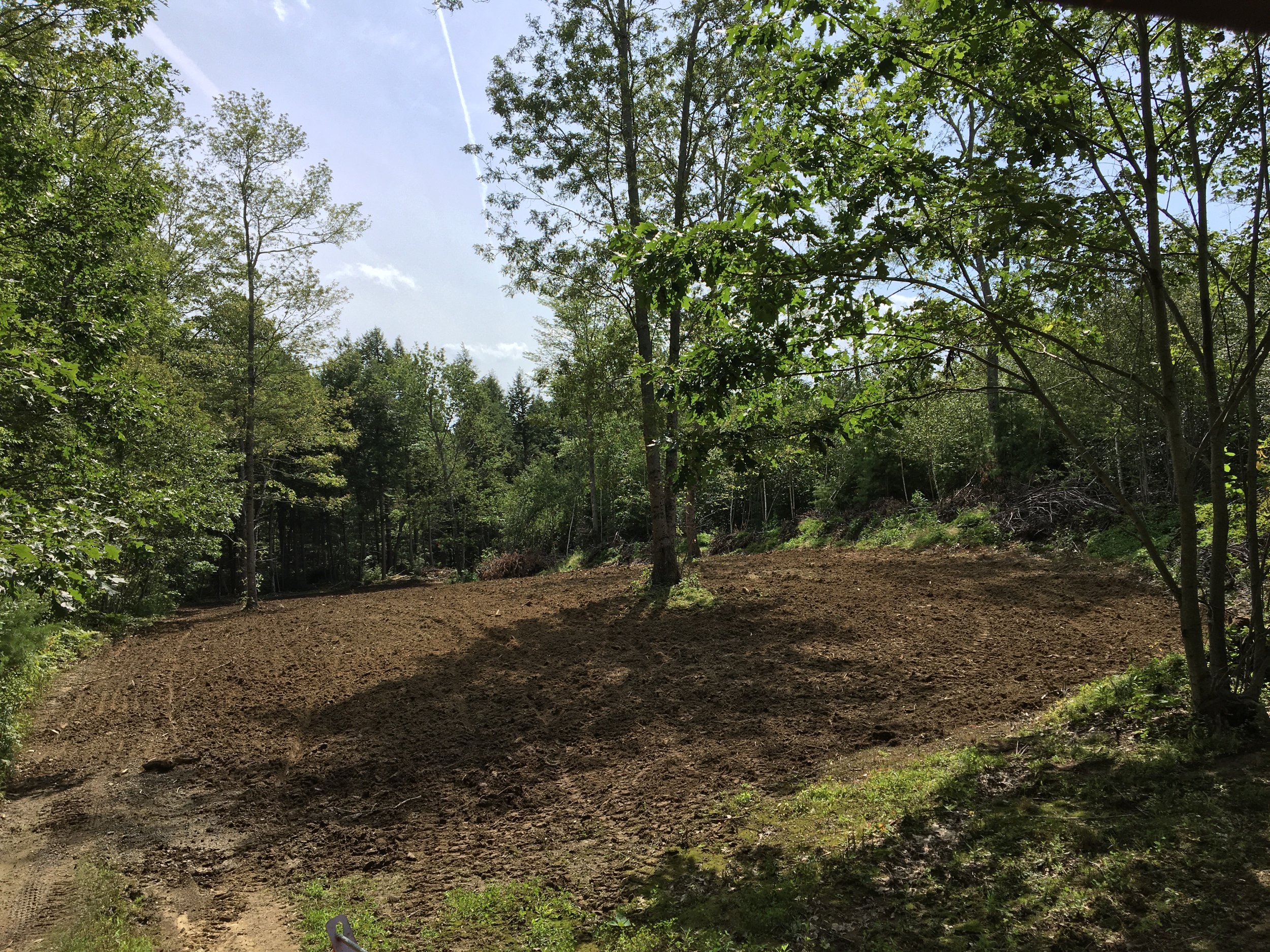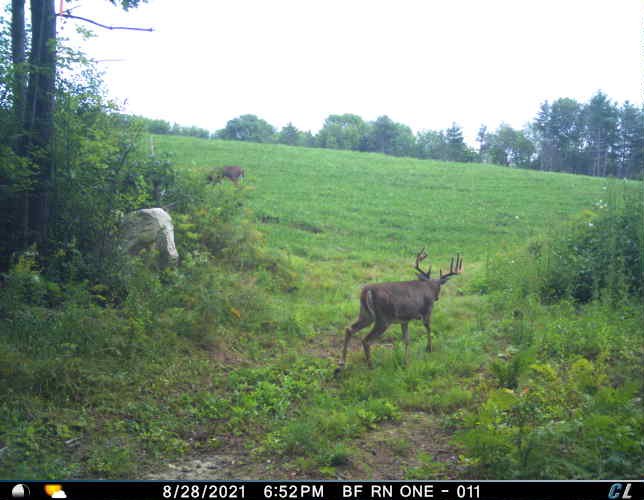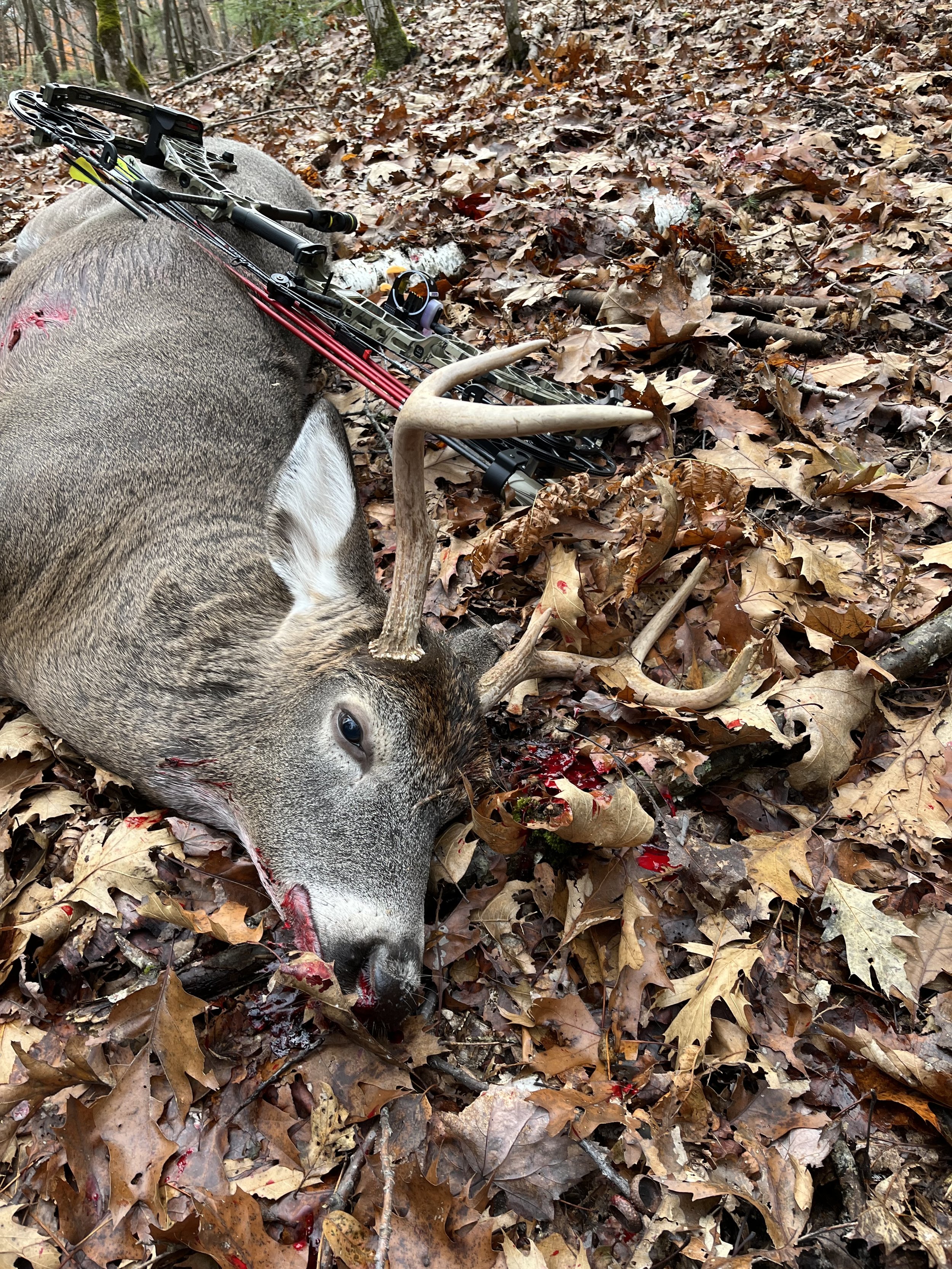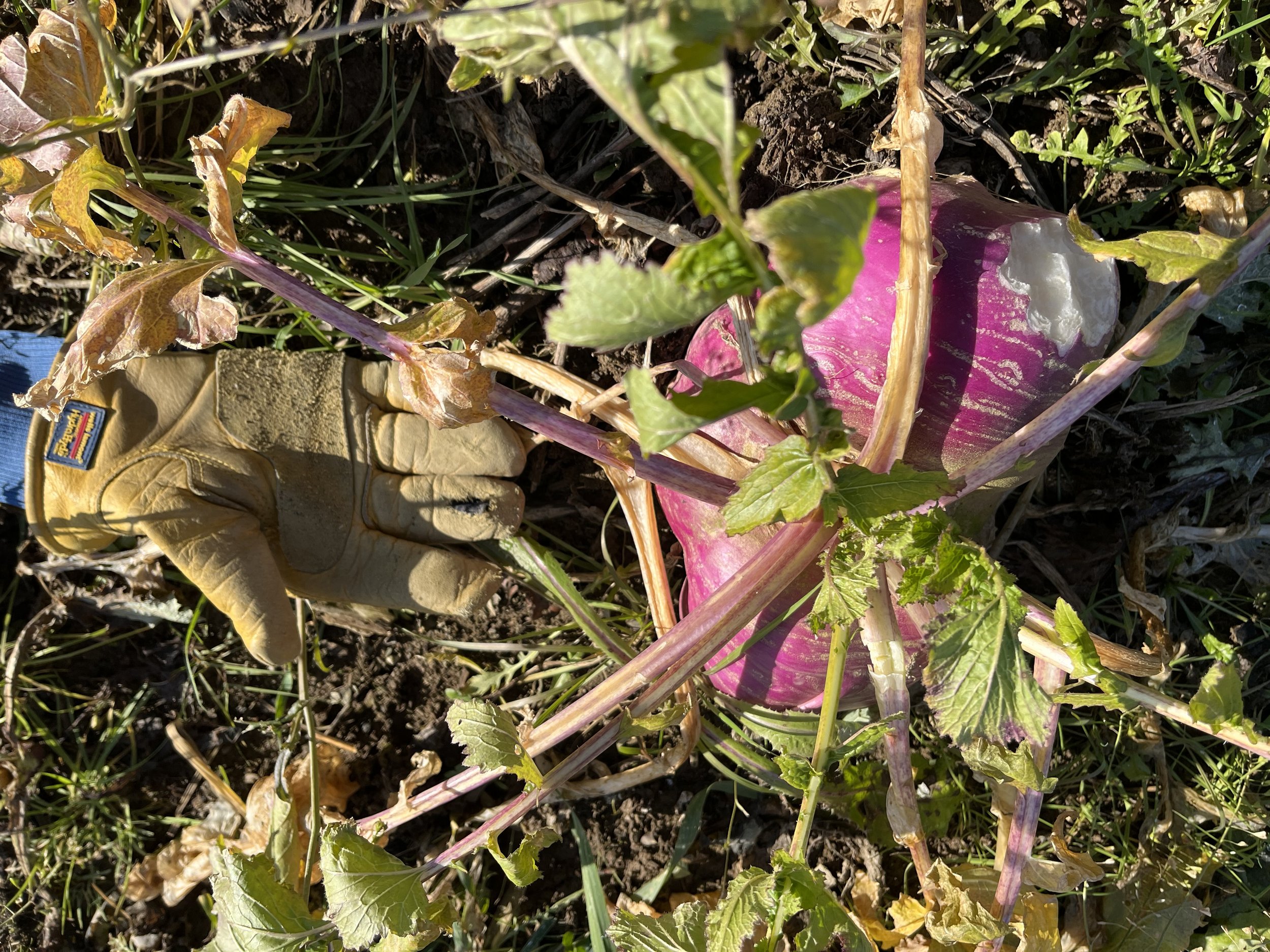2021 Land Management Case Study
Throughout the hunting season and into the winter I’m constantly thinking about what habitat improvements I want to make the following year. There are always a number of projects that I did not get to as the summer came to an end and the hunting season began. I usually continue to work on things during September and October, but will limit my work hours to the morning, and I’ll put the major projects that may disrupt bedding areas on-hold until the following year. The rut starts at the end of October, and that’s a time when bucks will increase their movement during the day, so projects come to a halt.
I tend to think of my projects in terms of how they will improve the hunting from my various blinds and tree stands. For example, when I hinge-cut a new barrier running east/west in the middle of the land last year, I expected it to improve the hunting at both the Pond plot on the west side and the Grove plot on the east side.
My 2021 plan called for hinge-cut barriers in several places, three new tree stands, relocating one stand, relocating one box blind and repositioning the other, cutting three new trails, and if I have time, building a new food plot. The trail south of the big field was on the 2020 project list, as was several of the hinge-cuts, and the food plot south of the barn. I planned to relocate the tree stand at the northeast corner of the big field to be farther back in the woods so I can enter and exit without being seen. The box blind on the east end of Big Clover needs to be moved down to where the tractor road enters the Big Field, and the blind at the northwest corner should be slid back closer to the timber.
Forestry mulcher - this thing is crazy!
There are spots for new tree stands in two locations on the west side of the property. One spot is in the northwest corner of the land, just to the west of a bedding area, and the goal is to be able to hunt deer coming and going from that bedding area when the wind is out of the south or east. And the other stand will go just south and west of the Instep plot, good for a north or east wind.
I bought a skid steer and forestry mulcher in 2020 to cut trails on the 722 acres I own in New Sharon, several towns to the north - I figured that, with all the trails I needed to cut, it would be far cheaper to own the mulcher for a couple years, rather than renting or contracting someone to do the work. In addition to the new land, I also plan to use the mulcher to cut a trail from the Grove plot to the Pond plot, and another trail from the Pond plot up to the Instep plot. The Diamond Forestry Disk Mulcher is a hydraulic powered attachment that rotates a five-foot wide, one-inch thick steel disk with teeth - it is incredibly powerful, sucking-in and chipping whole trees! It can easily cut and mulch trees up to six inches in diameter, so it will be perfect for the young regenerating hardwood trees in this part of my Gardiner land. The trails will be the path of least resistance for deer, giving them an incentive to go directly to a harvest food plot when leaving their bedding area in the afternoon. Considering the new barriers, trails, food plot, relocated blinds and stands, the 2021 planned improvements should help the hunting quality at a total of 12 stands and blinds.
The new location of this Redneck box blind is where the bucks are
I started in May by spraying my existing clover plots with herbicides that target grasses and broadleaf weeds without hurting the clover. I mix Slay and Arrest in the same tank, along with crop oil, so I only have to make one pass with the sprayer. The ground was fairly dry, so I could hit most of the food plots. Spraying should be done as early as possible in the spring because the herbicide works best on the new weed growth.
My son Haven was in-town and could help me relocate the two Redneck blinds. The first blind was too close to the trail and also needed to be turned so I can better shoot through the vertical corner windows. That was easily moved by tying a rope to the legs and using the UTV to drag it into position.
The other blind was at the east side of the Big Clover plot and hadn’t had much action, so I moved it to a spot by the Big Field where bucks had been entering the field the previous year. I learned from experience that the horizontal windows are not at a good height for shooting with a bow, so the two blinds are now positioned so the vertical corner windows have the best shot.
Hinge-cut barriers really work
The early spring temperatures are cooler, so this is when I like to get my manual grunt-work done. Working in the woods in July and August, with high humidity and temperatures, and bugs, is something to avoid - especially if you’re wearing heavy protective chainsaw gear. I hinge-cut a deer barrier running from the Instep plot southwest to the new West Exit plot that I hoped to grub-out this year. I also worked on extending my hinge-cut barrier running north from Instep. These two barriers would direct the deer travel in this area to pass through the Instep plot, and it would help keep trespassers on the west side from walking in anywhere they want. The new West Exit food plot would encourage deer to bed nearby and give me a good location to hunt a north or east wind. It would be about a third of an acre planted in perennial clover. I wanted to cut a couple new trails in this area, making it easy for deer to go from Instep, to West Exit, to Pond, and out to Grove or Lightning.
The weather turned warm in June and hinge-cutting became nasty work. A massive infestation of browntail moths also kept me out of the woods because they tend to fall onto my neck and arms when I’m working, causing a bad rash.
Tough work in thick hardwood regeneration
Establishing trails to direct bucks during the rut should help provide me with more hunting opportunities. The forestry mulcher cuts and chips the saplings as close to the dirt as I dare to go, so the margin of error really depends on the amount of rocks on the surface. This area doesn’t have a lot of rocks, so I can go down close to the dirt. Grasses and weeds will grow on these trails, providing bedded deer browse for their mid-day feeding.
The trails I have in mind would be cut through thick hardwood regeneration. This part of my land has flat ground that was good pasture land in the 1800’s. In my deed a right-of-way was given in the 1830’s for a neighbor to water their livestock at the ”bubbling spring” nearby, and water still flows from that spring. The pasture was long ago allowed to grow back to woods, and then the owner before me harvested the timber about 15 to 20 years ago. He clearcut the land, leaving a medium size oak or maple every fifty feet or so, and the saplings that have filled in are now about three to six inches in diameter. I have cut trails by hand through this stuff - it’s very hard going and the trail I can produce isn’t very wide. I have also used my tractor, with the backhoe or just with my rock grapple, and that is tough on the equipment.
My first step in making the trails was to walk through the thick woods and flag where I thought the trails should go. The whole time I paid close attention to the slope of the land, the consistency/dryness of the soil, the rocks, and the occasional bigger trees that had been left by the last timber harvest. My goal was to wind the trail between the start and finish, and avoid obstacles in between. A trail with twists and turns is preferable to a straight trail because bucks in the rut will be forced to walk the trail to make sure they know where all the does are.
My mulcher cuts awesome trails for deer travel!
I cut a trail from the west corner of the Instep plot down to where I would be building the new West Exit plot, following the general run of the new hinge-cut barrier. The deer from the bedding area would find the trail to be the easy way off my land to the west, taking them to the West Exit plot for a bite to eat - and that would be where I would hang a new stand.
Another trail was cut from West Exit to the Pond plot, and then one from Instep to intersect with this trail. I learned a lesson cutting the intersecting trail down to the West Exit/Pond trail because I didn’t bother flagging the route in advance. I thought it was straightforward, and I had hand-cut a trail on that route a few years back that I thought I would follow. Well, the old trail went between sprouted oak stumps that I wanted to avoid, and soon I was off the trail. I went too far to the east and my new trail came out on the tractor road that runs from Big Clover to Pond! The final result was ok, but when you cut a new trail you will be living with it for years to come so you have to get it right.
Running a skid steer with a forestry mulcher on the front is very stressful. You are always in fear of breaking something or getting stuck. The constant state of fear manifests itself like something sitting in the pit of your stomach. It is incredibly productive for this sort of job, but you can’t help but think that something could go wrong at any second.
Dumping a load of cow manure on Grove
I cut a trail in from the Grove plot, and one from Lightning, joining together in the middle of the east side of the bedding area. I then cut over to the Pond plot, and this completed the trails that I would be able to do in 2021. I hadn’t been able to cut the trails in the north and south, and would have to get to them in 2022. There were a few places where rocks, wet areas, or topography had made it hard to cut, but so far I had been working on land that was well suited to the machine.
With the trail cutting done, I started on the food plots. I sprayed glyphosate on the two acres that I had in soybeans in 2020 with the plan to plant a fall annual mix there in mid-August. I had grubbed-out the Grove plot in 2020 but the drought had kept my planting from working, so I would re-do that in 2021. Usually my plots were thick with regenerating hardwoods and need to be cleared with a bulldozer or backhoe. I wanted a new small plot next to the Redneck blind we had just moved to the edge of Big Field, but that area was already in good shape and mostly just needed to be disked.
The Grove plot was now disked with manure and ready to plant
I had planned to put in a new food plot just south of the barn, but the area was just too wet to work the soil, so I decided to concentrate my efforts on the better soil southwest of the Instep plot. Grubbing out this new West Exit food plot would be a major undertaking, similar to creating the Grove plot in 2020. I also really liked the results I had seen at the Garden plot when I spread cow manure on it, so I wanted manure on the two new plots and Grove.
The new plot by Big Field would be just inside the woods from a break in the berm that surrounds the field. I had watched from afar as trophy bucks entered the field through that break in 2020, and now I would have a Redneck blind within 30 yards of the break. With a small food plot at the break in the berm, my hope was that deer would stop and get a bite to eat before they entered the open field, increasing the traffic in front of the blind, and giving me time to make a good shot. I used my backhoe to grub out the few stumps in this area, but mostly just used the bucket, landscape rake, and disk harrow to beat the soil into shape. I finished with several loads of cow manure, then spread lime and clover seed.
The new West Exit food plot before cultipacking and seeding
The Grove plot already had lime spread on it in 2020, so it just needed the manure dumped and raked-in. With a smooth seed bed prepared, I then use a cultipacker to roll the ground flat, broadcast the seed, and then roll it again. I use a cone spreader for the seeding - mixing the seed with lime so I can fill the large spreader, and then driving over the plot many times to be sure to get an even distribution of the mix. This method is easier, and works far better, than using a hand-held broadcast seeder.
Grubbing-out the West Exit plot took weeks. I have described the process before - backing the backhoe into position, ripping out the trees and stumps, pushing them out of the way with the bucket, repositioning the backhoe, and doing it again. There were a couple large oak stumps that took a lot of work, but mostly it went well. The soil was good and dry, only turning wet on two edges, and I discovered a rare white oak in the south lobe that I left intact.
It was now the end of August and I shifted my attention to my New Sharon property. I cut trails and cleared old logging loading areas using the forestry mulcher. I bought a Polaris Ranger UTV for that property and a pre-fab garage to protect it from the elements. That kept me busy until the expanded archery season opened September 11th.
2021 was my best deer hunting season by far, but it started poorly. As always, I start the season hunting from treestands that are close to my access points, and then hunt deeper into the property as the season advances. This way, I have a good chance of harvesting a deer close to the barn or the south entrance before my afternoon and evening movement is patterned by the deer that frequent these areas.
I had some great deer on-camera heading into the season
Opening day found me with a west wind hunting the Barn plot. I had patterned the deer well, so it was no big surprise that I had action all evening long - a total of three does, five fawns, and a three-point yearling buck all gave me shot opportunities, though fawns and yearling bucks are off-limits for me. A mature doe browsed on clover until she was just 20 yards from my stand, giving me a perfect broadside shot. Unbelievably, my arrow skipped off her back, burying itself in the ground and leaving no trace of blood! A while later another doe was at 30 yards when I shot clean over her! The third mature doe came in completely on-edge - she might have come in from down wind and smelled the Ozonics unit I was using - but after the first two flubs I wasn’t going to try shooting anymore that night.
Maybe the second shot was a misjudgment of the distance (didn’t seem like it, but maybe) but the first shot was definitely a broadhead malfunction. I was shooting Wasp Jackhammer mechanical broadheads on a heavy arrow, with my new Matthews V3, and my pin was right on the vitals. The shot should have been super easy, but instead the arrow hit above and far to the right. I’m positive that the mechanical blades deployed in mid-flight, causing the broadhead to turn the arrow. I’ve had this happen before, but only in practice. I killed a doe with a Jackhammer in 2020 and it worked perfectly.
Trespasser walking onto my land
After opening day I switched my broadheads back to the G5 Montec fixed-blade. I tried to duplicate the malfunction of the Wasp Jackhammer on the range, but couldn’t. Nevertheless, I felt that the prudent thing was to take the broadhead out of the equation. The Montec has better penetration than a mechanical, and I have had two pass-through shots with this broadhead on bull elk. Mechanical broadheads should be more accurate because there is less surface area to catch the wind in-flight, but the fixed-blade Montec seems to fly just fine on my heavy arrows. Better penetration and good accuracy, ok - so why even consider a mechanical broadhead? My only beef with a fixed-blade is that they have a smaller cutting diameter - so maybe the hemorrhaging is not as fast and the blood trail they produce is not as easy to follow. That may or may not be, but the reality is that a well-placed shot will kill a deer painlessly and fast, regardless of the type of broadhead used.
During the weekend I had a couple trophy bucks on-camera at the Instep stand, so I planned to hunt that area on the 14th. The night before my hunt I checked my camera emails and saw a trespasser walking by at 7:36 PM and then again at 9:34 PM! I was pissed, and went out the next morning to put more posted signs up in that area. The hunter actually came-by and explained that he had been tracking a wounded deer from the neighbor’s property. Ok, a good reason to come onto my land, but after he and a friend spent two hours tramping through a bedding area I didn’t get a buck on camera for weeks!
September 28th doe
It wasn’t until September 28th that I got another shot opportunity at a mature deer. I was hunting the Ledges plot with a very light swirling north wind. This stand works in a north wind because the deer come from the bedding area to the west and north, but the stand is a little low and the deer easily notice any movement I make. I intended to move the stand higher on the tree this year, but the browntail moth caterpillars were all over everything and I didn’t want to risk the rash. The three-point came in early, followed by a couple fawns, and finally by a group of two does and two fawns. I carefully turned to face one of the does, not the largest one, and made a good shot low to the heart. She ran about 70 yards and tipped-over on the tractor road. A nice 90 lb. doe for the freezer.
After hunting several times in other stands, I was back in the Ledges stand on October 5th. The doe that I had hit on opening day came in to feed, along with two fawns - she had a visible cut on her back, but was otherwise just fine. I carefully reached back to grab my bow, but when I turned my head to look at her she was staring at me. She had seen me move! I froze with my hand still on the bow, and the bow still on a hook on the tree. She was spooked, and for the next several minutes she stomped back and forth as I was frozen in an awkward position, head toward her with my arm reaching behind me. If my hand hadn’t been supported by the bow I couldn’t have stayed still for that long.
Finally she turned her head away from me for a moment and I immediately brought the bow around and faced her. She saw something and froze. I froze. She continued to stomp around, clearly mad that there was something up in the tree that shouldn’t be there. As the stomping hissy-fit continued, I was able to hook my release onto the D-loop, and when she turned away from me again I drew the bow. She once again saw something and froze, but this time I was able to shoot. 30 yards broadside, and it looked like I hit her a little back.
My Canadian nine-point dressed out at 248 lbs.
The doe ran out of the food plot and I settled-in to wait. What followed was a hard tracking job as she ran into the swamp/bedding area just south of the barn, and a very, very, nasty recovery as I dragged her through the thick cover well after dark. I almost gave up as I became exhausted and my muscles cramped, but I kept going and the result was a 104 lb. doe for the freezer.
Over the next five weeks I hunted 10 days on my property and saw a bunch of deer - a few does and small bucks gave me shot opportunities, but I had venison in the freezer and my rule for bucks has evolved. I now only want to harvest older bucks. They have to go up on the wall. Mature does for their meat, and to balance the buck/doe ratio, but no bucks younger than 3 1/2. So while I was hunting for an old buck on my land, I went bowhunting in Saskatchewan at the beginning of November and brought home a really nice deer (click on Return to Paradise for that story).
November 15th five-point buck
Back in Maine on November 15th, with the rut heating-up, I took my climber and was hunting just below where the hand-cut trail from Big Clover exits my property on the east side. It was midday and I saw a buck come off the ridge and cross into the timber. He paused for a moment 40 yards away, but was behind a bunch of branches so I had no shot. I quickly dug my call out of the pack and gave a couple grunts. He froze, and I gave a couple more, tending grunts, trying to project the sound behind my tree, pretending that I was a buck with a doe. He bought it and started down at an angle that would take him about 20 yards downhill from my stand. As he approached I came to full draw, and when he hit my shooting lane I made a mouth grunt to stop him. Releasing the arrow, I watched it hit perfectly and him wheel around and sprint up the hill to the south.
I waited a full hour after the shot before climbing down and tracking him. Once again the blood trail from the fixed-blade broadhead wasn’t dramatic, but it wasn’t hard to follow and he only went about 100 yards. He was a 3 1/2 year old 5-point that dressed out at 176 lbs, and not a deer that I was familiar with. He was the first older deer that I have taken off my land, and it was a thrill to grunt him in and make a perfect double-lung shot.
With one more buck tag in my pocket for the 2021 season, I kept at it, hunting for one of the monsters I had seen on-camera this year. On November 20th I was hunting the newly relocated Redneck Two box blind by the new little food plot and a gap in the berm on the northwest edge of Big Field. It was a warm sunny day with the wind out of the north that was forecast to switch to the south in the afternoon. The deer usually come from the north, so you would think that a south wind would be wrong for this spot, blowing my scent to the deer when they approached. However, my plan was to keep the windows closed in the Redneck box blind, and that should hold my scent in.
The radishes in Honey Hole were huge, and a huge draw for the deer
The Big Field had two acres of an annual mix that was close to the Redneck blind. I had combined Antler King Honey Hole with Antler King Fall/Winter/Spring and the results in the late season were fantastic. The industry always talks about brassicas getting “sweeter” after the first frost, but I have read that their sugar content doesn’t change, and deer just like their simple sugars in the later fall when acorns have started to be depleted. Regardless, the deer were hammering this section of Big Field from the early rut well into winter.
During the early season I had tried hunting this blind on a sunny day. In September, when it is warm out and the sun is on the blind, it gets blazing hot inside - really too hot to be comfortable. Today the temperature was in the mid 40s, so the warmth in the box blind was just fine. I expected the wind to shift in the afternoon and then the deer would be walking into the south wind as they approached the break in the berm, which they would be comfortable with. After dark the deer would be in the field and then the wind should be blowing my scent away from them as I leave.
One of two monster bucks that I had on camera all season
In the early afternoon I saw three does come into the field through the gap in the northeast corner, but they didn’t stay in the field very long. I was comfortable in the warm stand, boots off and stripped down to my base layers. At 3:00 PM I caught a glimpse of a buck coming out of the woods to the north, heading for my gap. I immediately opened the vertical window and grabbed my bow. The buck stopped for a bite to eat in the new food plot, giving me time to get a good look at him, and then he started to walk into the field. I quickly recognized that he wasn’t one of the monsters, so I hesitated. But only for a moment. He was at least 3 1/2 with a nice rack, and I had spent the last eight years working toward this. Who knows if and when I would get another chance. As he walked by at 30 yards I mouth-grunted to stop him, and then made a perfect broadside shot. He ran off into the field and toward the east, dropping out of site as the field drops off into a large gully.
Wow! Another perfect scenario that came together because of all the hard work I had put in over the years, combined with the knowledge I’d gained of how the deer move around my land. My fourth deer taken on the land this year and the second of the two older bucks I had ever harvested here. I packed up my gear and climbed down from the blind. My arrow had passed through the buck and was driven into the dirt of the berm at the far side of the gap. I started to track the blood trail as it led into the field, but the radishes in the food plot were so big it was like walking, and tracking, through a pumpkin patch.
November 20th nine-point buck
The G5 Montec fixed blade broadhead has a cutting diameter of 1 1/8 inches, compared to many mechanical blades that have a 2 inch cutting diameter so, once again, the blood trail wasn’t very impressive. And the three-dimensional nature of the brassica plot made the blood harder to see. So as I crested the high point of the plot I started to scan the rest of Big Field to see if I could spot the buck. He was less than 100 yards away, lying in the native grasses at the bottom of the big gulley, looking like he had been running toward the northeast gap when the damage from my shot caught up with him. I had seen this buck recently on my trail cameras, noting the mass of his antlers - he was a nine-point that dressed out at 142 lbs. and I think he was 3 1/2 years old.
So here it was, not even Thanksgiving, and for the first time I could remember I had taken more deer than I could use. I could still buy archery doe tags for the expanded zones, and continue to hunt my land, but I felt that I had had a fantastic season and this should be the end. I probably needed to harvest a few more does to balance the sex ratio, but that wasn’t really critical, so I turned my attention to scouting and planning for the next season. And I donated a lot of venison to the Belgrade Food Pantry and the Augusta Food Bank, as well as friends and family!
Two of my monster bucks that made it through the 2021 hunting season
Over the next six weeks I hiked most every inch of my land, going into places that I had never been, and noting trails and bedding areas. I even found an old cellar hole, fallen down chimney, and a dug well that I think was the homestead for the southern side of my land - folks that probably farmed what is now the Big Field. The snow in November and December showed me where the deer were moving during the hunting season. I flagged new trails that I plan to cut, flagged gaps where deer are getting through my barriers, and found the locations for six new treestands. Just about all of my stands so far have been located over food plots, so what I’ve been missing have been stands where I can intercept bucks that are cruising during the rut, checking doe bedding areas and travel corridors. I am very excited about the potential most of these new stands will have next season.
The mix of Antler King Honey Hole and Fall/Winter/Spring was an incredible draw for deer after the first frost and into the winter. In late January, as bucks were starting to show-up on trail cameras with dropped antlers, deer were still visiting the Big Field everyday. I had seen this the previous year when they were eating soybean pods, but not to this degree. The simple sugars contained in the brassicas would give the deer herd a boost going into the winter.
Deer came everyday for Brassicas, even well into January
My fawn recruitment improved significantly in 2021. I think I had 8 to 10 fawns living on my 108 acres during the year - up from just a few the year before. The doe population was thriving, and I had 3 or 4 mature bucks that made it through the hunting season. I had created the food and cover to support a robust deer population, and my strategy for low hunting pressure had kept them on my property. The results of my work keep getting better every year!
To keep reading about my land management project, Click Here To Go Forward To 2022
To go back to the previous page, Click Here To Return To 2020.
